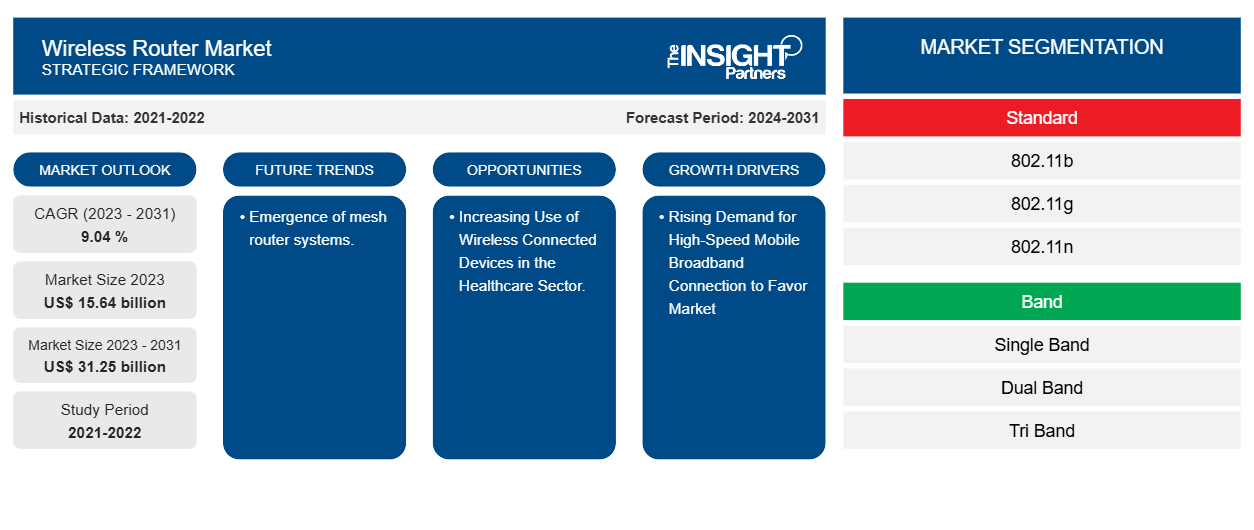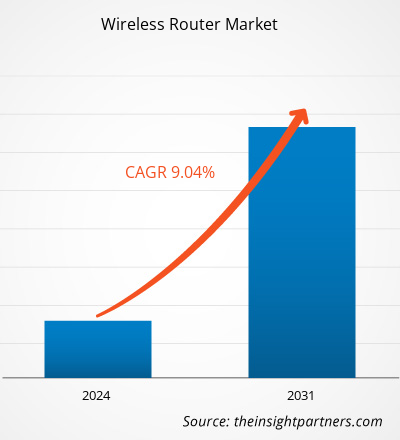The wireless router market size is projected to reach US$ 31.25 billion by 2031 from US$ 15.64 billion in 2023. The market is expected to register a CAGR of 9.04 % in 2023—2031. The growing need for high-speed internet and smart home gadgets are likely to remain key wireless router market trends.
Wireless Router Market Analysis
The wireless router market is growing at a rapid pace as a result of the growing need for high-speed internet, increase in online working and distant work, expansion of 5g infrastructure, growth in internet penetration, etc. Moreover, rapid digital transformation amongst end-user verticals and increasing resilience on wifi systems are providing lucrative opportunities for market growth.
Wireless Router Market Overview
One of the most well-known features of wireless routers is the integration of wireless access points for private computer networks or the Internet. Depending on the manufacturer and kind, wireless routers can be used on a hybrid wired and wireless network, a wired local area network, or a wireless-only LAN. The market for wireless routers is expanding swiftly and is probably going to continue doing so in the next years.
Customize This Report To Suit Your Requirement
You will get customization on any report - free of charge - including parts of this report, or country-level analysis, Excel Data pack, as well as avail great offers and discounts for start-ups & universities
Wireless Router Market: Strategic Insights

-
Get Top Key Market Trends of this report.This FREE sample will include data analysis, ranging from market trends to estimates and forecasts.
Wireless Router Market Drivers and Opportunities
Rising Demand for High-Speed Mobile Broadband Connection to Favor Market
The need for internet access, the availability and affordability of smartphones, the decreased cost of technology per megabyte of data, and the absence of fixed-line access in some developing countries are some of the reasons that, when combined, are propelling mobile broadband connectivity globally. Furthermore, roughly 93% of smartphone users say they use their devices primarily at home, according to a study conducted by industry behemoth Google, Inc. As a result, the market is seeing significant technological advancement due to the increased traction among industry participants brought about by the increasing adoption of mobile broadband. The market for mobile broadband is anticipated to rise, which should positively affect the market for wireless routers year over year.
Increasing Use of Wireless Connected Devices in the Healthcare Sector.
A surge in the use of connected healthcare devices among healthcare professionals, such as heart-remote patient monitoring devices and rate monitors, is driving global market expansion. The linked medical device also enables healthcare professionals to concentrate on active patient involvement and give care that is centered on the needs of the patient. Since these services depend on fast internet communication between patients and doctors, the industry is expanding as a result.
Wireless Router Market Report Segmentation Analysis
Key segments that contributed to the derivation of the wireless router market analysis are standard, band, application, and end-use.
- Based on standards, the wireless router market is divided into 802.11b, 802.11g, 802.11n, 802.11AC, and 802.11AX. The 802.11b segment is anticipated to grow in the forecast period.
- By band, the market is segmented into single-band, dual-band, and tri-band. The single-band segment is anticipated to grow in the forecast period.
- Based on application, the wireless router market is divided into household, commercial, enterprise, and transportation. The trademark segment is anticipated to grow in the forecast period.
- In terms of end-use, the market is bifurcated into indoor and outdoor. The indoor segment is anticipated to grow at a significant rate over the forecast period.
Wireless Router Market Share Analysis by Geography
The geographic scope of the wireless router market report is mainly divided into five regions: North America, Asia Pacific, Europe, Middle East & Africa, and South America/South & Central America. North America has dominated the wireless router market. High technology adoption trends in various industries in the North American region have fuelled the growth of the wireless router market. Factors such as increased adoption of digital tools and high technological spending by government agencies are expected to drive the North American wireless router market growth. Moreover, a strong emphasis on research and development in the developed economies of the US and Canada is forcing the North American players to bring technologically advanced solutions into the market. In addition, the US has a large number of wireless router market players who have been increasingly focusing on developing innovative solutions. All these factors contribute to the region's growth of the wireless router market.
Wireless Router Market Report Scope
Wireless Router Market Regional Insights
The regional trends and factors influencing the Wireless Router Market throughout the forecast period have been thoroughly explained by the analysts at The Insight Partners. This section also discusses Wireless Router Market segments and geography across North America, Europe, Asia Pacific, Middle East and Africa, and South and Central America.
Wireless Router Market Report Scope
| Report Attribute | Details |
|---|---|
| Market size in 2023 | US$ 15.64 billion |
| Market Size by 2031 | US$ 31.25 billion |
| Global CAGR (2023 - 2031) | 9.04 % |
| Historical Data | 2021-2022 |
| Forecast period | 2024-2031 |
| Segments Covered |
By Standard
|
| Regions and Countries Covered |
North America
|
| Market leaders and key company profiles |
|
Wireless Router Market Players Density: Understanding Its Impact on Business Dynamics
The Wireless Router Market is growing rapidly, driven by increasing end-user demand due to factors such as evolving consumer preferences, technological advancements, and greater awareness of the product's benefits. As demand rises, businesses are expanding their offerings, innovating to meet consumer needs, and capitalizing on emerging trends, which further fuels market growth.

- Get the Wireless Router Market top key players overview
Wireless Router Market News and Recent Developments
The wireless router market is evaluated by gathering qualitative and quantitative data post primary and secondary research, which includes important corporate publications, association data, and databases. The following is a list of developments in the market:
- In January 2024, - Acer announced two new gaming routers, leveraging the power of the Qualcomm Immersive Home Platform and tri-band wifi 7 for stable connections and enhanced wireless gameplay. The Predator Connect X7 5G CPE unleashes blazing-fast internet speeds through 5G and wifi 7, along with dual WAN connectivity to minimize disruptions.
(Source: Acer, Press Release, 2024)
- In September 2023, Charter Communications, Inc. and Qualcomm Technologies, Inc. announced a collaboration to deliver the next-generation Advanced wifi router that will bring wifi 7 and 10 Gbps wifi capabilities to Spectrum Internet users, helping support and enhance the converged connectivity experience for residential and small and medium-sized business customers. Advanced wifi routers with wifi 7 are expected to be available to Spectrum customers in 2024..
(Source: Charter Communications, Inc, Press Release, 2023)
Wireless Router Market Report Coverage and Deliverables
The "Wireless Router Market Size and Forecast (2021–2031)" report provides a detailed analysis of the market covering below areas:
- Market size and forecast at global, regional, and country levels for all the key market segments covered under the scope
- Market dynamics such as drivers, restraints, and key opportunities
- Key future trends
- Detailed PEST/Porter's Five Forces and SWOT analysis
- Global and regional market analysis covering key market trends, major players, regulations, and recent market developments
- Industry landscape and competition analysis covering market concentration, heat map analysis, prominent players, and recent developments
- Detailed company profiles
Frequently Asked Questions
What is the estimated market size for the global wireless router market in 2023?
What are the driving factors impacting the global wireless router market?
What are the opportunities of the global wireless router market?
Which are the key players holding the major market share of the wireless router market?
What will be the market size for the global wireless router market by 2031?
- Historical Analysis (2 Years), Base Year, Forecast (7 Years) with CAGR
- PEST and SWOT Analysis
- Market Size Value / Volume - Global, Regional, Country
- Industry and Competitive Landscape
- Excel Dataset
Recent Reports
Related Reports
Testimonials
Reason to Buy
- Informed Decision-Making
- Understanding Market Dynamics
- Competitive Analysis
- Identifying Emerging Markets
- Customer Insights
- Market Forecasts
- Risk Mitigation
- Boosting Operational Efficiency
- Strategic Planning
- Investment Justification
- Tracking Industry Innovations
- Aligning with Regulatory Trends





















 Get Free Sample For
Get Free Sample For